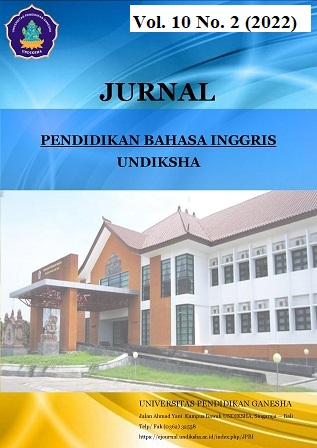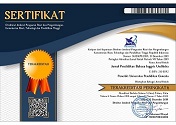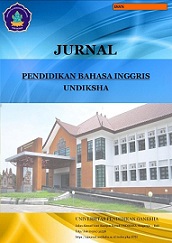An Analysis of Lexicons Related to Wura Bongi Monca Dance in Bima
DOI:
https://doi.org/10.23887/jpbi.v10i2.57102Keywords:
Language Maintenances, Wura Bongi Monca Dance, Lexicon, Word Formation, Word ClassesAbstract
Wura Bongi Monca dance is a classic dance from Bima NTB which has its lexicons. This culture is very important, because if the culture is lost, then the lexicon in dance will be lost.Base on those reason this research was designed in the form of descriptive qualitative study which aimed to analyses lexicons and their culture meaning, their word formations, as well as their word classes. The data of the study were in the forms of primary and secondary data. The primary data were obtained using observing and interviewing technique while the secondary ones were taken from analyzing the relevant documents found in Bima Museum, NTB. The results of this study show that: (a) 23 lexicons were found in the dance and divided into 3 parts: namely, 7 are connected to its dance movements, 12 to its costumes, and 4 to its musical instruments; (b) In term of its word formations, 2 types were found; compounding (13), and borrowing (3); and (c) In term of the lexicon word category, only 3 word classes were found: nouns (27), adjectives (9), and verbs (2).
References
Alghasani, Y., & Rosa, R. N. (2022). An Analysis of Word Formation in Ariana Grande Song Lyrics from The Album “Sweetener.” English Language and Literature, 11(1), 96–109. https://doi.org/10.24036/ell.v11i1.115782.
Boddaert, G., Cornut, C., & Casalis, S. (2021). Integration of newly learned L2 words into the mental lexicon is modulated by vocabulary learning method. Acta Psychologica, 212, 103220. https://doi.org/10.1016/j.actpsy.2020.103220.
Brentari, D., & Padden, C. (2001). Native and foreign vocabulary in American Sign Language: A lexicon with multiple origins. Foreign Vocabulary in Sign Languages: A Cross-Linguistic Investigation of Word Formation, 87–119. https://books.google.com/books?hl=id&lr=&id=Z60JBAAAQBAJ&oi=fnd&pg=PT107&dq=Brentari,+D.,+%26+Padden,+C.+(2001).+Native+and+foreign+vocabulary+in+American+Sign+Language:+A+lexicon+with+multiple+origins.+Foreign+Vocabulary+in+Sign+Languages:+A+Cross-Lingui.
Budasi, I. G. (2021). The Reconstruction of Etymon Proto of Sambori and Teta Isolects Spoken in Bima Regency-NTB-Indonesia. Jurnal Arbitrer, 8(1), 14. https://doi.org/10.25077/ar.8.1.14-24.2021.
Budasi, I. G., Indriani, M. S., & Ana, I. K. T. A. (2022). Lexicons in the Wura Bongi Monca Dance in Bima District. In STRUKTURAL (Seminar on Translation, Applied Linguistics, Literature, and Cultural Studies), 3(1), 84–92. https://doi.org/10.33633/str.v3i1.7603.
Budasi, I. G., & Indriyani, N. M. S. (2020). Genetical Status of Relatedness Between Sambori and Teta Dialects Spoken in Bima Reg ency, West Nusa Tenggara. Journal of Social Science Advanced Research, 1(2), 76–86. https://myjms.mohe.gov.my/index.php/jossar/article/view/11488.
Budasi, I. G., & Satyawati, M. S. (2021). An Ethnolinguistic Perspective on Lexicons of Traditional House in Menyali Village, North Bali. Jurnal Kajian Bali (Journal of Bali Studies), 11(1), 115. https://doi.org/10.24843/jkb.2021.v11.i01.p07.
Dewi, A. A. I. M. D. U., Gede Budasi, I., & Suarnajaya, I. W. (2020). Lexicons in Legong Keraton dance. Lingua Scientia, 27(2), 98–107. https://doi.org/10.23887/ls.v27i2.26422.
Fatimatuzzakrah, F., Suktiningsih, W., & Hastuti, H. (2020). The Cultural Value of Lexicon in “Ngendang” Tradition. Kajian Linguistik Dan Sastra, 5(1), 1–13. https://journals.ums.ac.id/index.php/KLS/article/view/10425.
Fatmawaty, R., & Anggraini, P. A. (2019). An Analysis Of English Word Formation Processes In Beats Apart Novel By Alanda Kariza And Kevin Aditya. E-Link Journal, 6(1), 164–182. https://doi.org/10.30736/ej.v6i1.125.
Gunantar, D. A. (2017). Textbooks analysis: Analyzing English as a Foreign Language (EFL) textbooks from the perspective of Indonesian culture. Journal of Language and Literature, 11(2), 173–182. https://repository.usm.ac.id/files/journalnas/z171/20180920070237-analisis-buku-teks-:-menganalisis-bahasa-inggris-sebagai-buku-teks-bahasa-asing-dari-perspektif-budaya-indonesia.pdf.
Iwan. (2017). The Analysis of the Word Classes Acquired By Two – Four Years Old Indonesian Children in Their First Language Acquisition. The 1st Education and Language International Conference Proceedings Center for International Language Development of Unissula, 441–447. http://jurnal.unissula.ac.id/index.php/ELIC/article/view/1258.
Kuo, M.-M., & Lai, C.-C. (2006). Linguistics across Cultures: The Impact of Culture on Second Language Learning.
Kusuma, I, M, A, W., Budasi,, I, G., & Suarnajaya, I, W. (2020). Lexicons of tabuh Rah used in menyali vilage. Jurnal Bahasa,Seni, Dan Pengajarannya, 15(2). https://doi.org/10.23887/prasi.v15i02.26906.
Kusuma, W. I. M. A., Budasi, I. G., & Suarnajaya, I. W. (2020). Lexicons of Tabuh Rah Used in Menyali Village. Prasi, 15(2), 71. https://doi.org/10.23887/prasi.v15i02.26906.
Lee, B. C., Pandian, A., Rethinasamy, S., & Tan, D. A. L. (2019). Effects of PWIM in the ESL classroom: Vocabulary knowledge development among primary Malaysian learners. 3L: Language, Linguistics, Literature, 25(4), 179–197. https://doi.org/10.17576/3L-2019-2504-11.
Luardini, M., & Sujiyani, E. (2018). Introducing Ecolinguistics in EFL Classroom. 262(Ictte), 375–382. https://doi.org/10.2991/ictte-18.2018.70.
Mayangsari, Y. R., & Firdaus, F. (2022). Makna Komunikasi Simbolik Tarian Mpa’a Ntumbu Tuta di Kecamatan Wawo Kabupaten Bima. Professional: Jurnal Komunikasi Dan Administrasi Publik, 9(2), 503–512. https://doi.org/10.37676/professional.v9i2.3429.
Ni Made, R. (2015). Kesenian Kecimol Merupakan Simbol Kemapanan Masyarakat Di Lombok Timur. Kalangwan Jurnal Seni Pertunjukan, 1(1). http://repo.isi-dps.ac.id/id/eprint/2946.
Nur’aini, A. B., Triana, J., & Fogli, L. (2021). The Analysis of Word Formation in Movie “Wonder” and Its Application in Teaching Vocabulary. Scripta : English Department Journal, 8(2), 20–27. https://doi.org/10.37729/scripta.v8i2.702.
Qiong, O. U. (2017). A brief introduction to perception. Studies in Literature and Language, 15(4), 18–28. https://doi.org/10.3968/10055.
Rabiah, S. (2018). Language as a Tool for Communication and Cultural Reality Discloser. 1–11. https://doi.org/10.31227/osf.io/nw94m.
Rina Devianty. (2017). Bahasa Sebagai Cermin Kebudayaan. Jurnal Tarbiyah, 24(2), 226–245. https://doi.org/10.30829/tar.v24i2.167.
Saddam, S., Bidaya, J., & Isnaini, I. (2023). Tradisi Dan Adat-Istiadat Masyarakat Suku Kore Kecamatan Sanggar Kabupaten Bima. Historis: Jurnal Kajian, Penelitian Dan Pengembangan Pendidikan Sejarah, 7(2), 1–11. https://doi.org/10.31764/historis.v7i2.9676.
Suktiningsih, W. (2016). Leksikon Fauna Masyarakat sunda: Kajian Ekolinguistik. RETORIKA: Jurnal Ilmu Bahasa, 2(1), 138–158. https://doi.org/10.22225/jr.2.1.241.138-156.
Suwonsichon, S. (2019). The Importance of Sensory Lexicons for Research and Development of Food Products. Foods, 8(1), 27. https://doi.org/10.3390/foods8010027.
Tarigan, B., & Sofyan, R. (2018). Maintaining Karonese Ecolexicon through Traditional Game Cengkah-cengkah. International Journal of Applied Linguistics and English Literature, 7(4), 177. https://doi.org/10.7575/aiac.ijalel.v.7n.4p.177.
Tjendani, E. N., Suastra, I. M., Mbete, A. M., & Seri Malini, N. L. N. (2019). An Ecolinguistics Perspectives For English Syllabus Development. E-Journal of Linguistics, 13(2), 249. https://doi.org/10.24843/e-jl.2019.v13.i02.p06.
Tuna, ÿzlem K., & Razı, S. (2016). Integrating Culture into ELT Classes: What, Why, and How? Procedia - Social and Behavioral Sciences, 232, 41–48. https://doi.org/10.1016/j.sbspro.2016.10.009.
Yayuk, R. (2018). Lexicon of Characteristic Disclosure of River Culture at Banjarmansin and Nagara Societies: An Ethnosemantic Study. Naditira Widya, 12(2), 131–146. https://doi.org/10.24832/nw.v12i2.312.
Yuniawan, T., Rokhman, F., & Mardikantoro, H. B. (2018). The Journal of Educational Development Eco-Lexicons in Conservation News Text in Mass Media : Ecolinguistics Study. The Journal of Educational Development, 6(1), 1–15. https://journal.unnes.ac.id/sju/index.php/jed/article/view/16270.
Downloads
Published
Issue
Section
License
Copyright (c) 2023 Maria Yuliana Geofany, I Gede Budasi , Dewa Ayu Eka Agustini

This work is licensed under a Creative Commons Attribution-ShareAlike 4.0 International License.
Authors who publish with the Jurnal Pendidikan Bahasa Inggris Undiksha agree to the following terms:- Authors retain copyright and grant the journal the right of first publication with the work simultaneously licensed under a Creative Commons Attribution License (CC BY-SA 4.0) that allows others to share the work with an acknowledgment of the work's authorship and initial publication in this journal
- Authors are able to enter into separate, additional contractual arrangements for the non-exclusive distribution of the journal's published version of the work (e.g., post it to an institutional repository or publish it in a book), with an acknowledgment of its initial publication in this journal.
- Authors are permitted and encouraged to post their work online (e.g., in institutional repositories or on their website) prior to and during the submission process, as it can lead to productive exchanges, as well as earlier and greater citation of published work. (See The Effect of Open Access)













